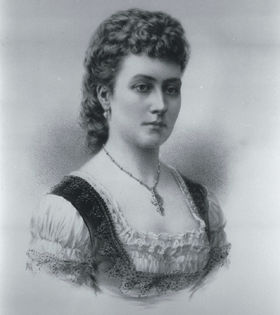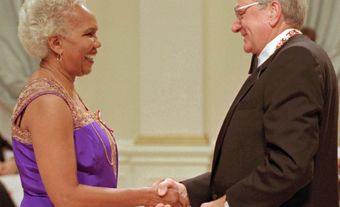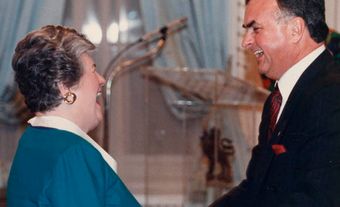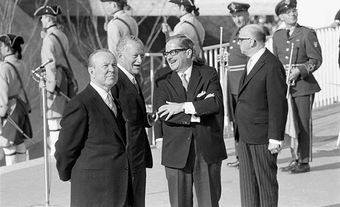
Early Life and Family
Lorne was born in London at Stafford House (now Lancaster House), which then belonged to his maternal grandparents, the Duke and Duchess of Sutherland. He was the eldest of the 12 children of George Douglas Campbell, Marquess of Lorne and Lady Elizabeth Georgiana Sutherland-Leveson-Gower, an abolitionist who served as Mistress of the Robes to Queen Victoria. When Lorne was 21 months old, his father became the 8th Duke of Argyll and joined the House of Lords. Lorne received the courtesy title of Marquess, which he held until age 54, when he succeeded his father as Duke of Argyll. Lorne spent much of his childhood at Argyll Lodge in London and Inveraray Castle in Scotland.
Education and Travel
Lorne was educated by private tutors until the age of 13 when he was sent to the Edinburgh Academy for a year and then to Eton College for his secondary education. In 1862, he enrolled in the University of St. Andrews and then spent a year at Trinity College, Cambridge in 1864–65. As an adult, Lorne complained that his classical education had not prepared him for his later career, writing, “But the living Britain, her Colonies and dependencies, the living action in European and other states, we were not taught to know.”
In 1866, Lorne visited Canada for the first time at the end of a larger tour of North America and the Caribbean. He described Toronto as “too dull for words” but admired the stone houses and attractive harbour in Kingston. In Ottawa, he dined with the Governor General, Viscount Monck.
Royal Marriage
On 21 March 1871, Lorne married Princess Louise, the fourth daughter of Queen Victoria, in St. George’s Chapel, Windsor Castle. The marriage was controversial because there had not been a marriage between a princess and a subject of the British Crown (as opposed to a member of a foreign royal family) since King Henry VIII’s sister, Mary, married Charles Brandon, Duke of Suffolk, in 1515. Queen Victoria was supportive of the marriage but her eldest son, the future Edward VII, was opposed to the match.

At the time of his engagement, Lorne wrote to one of his sisters that “it is not a mariage de convenance” (marriage of convenience) and that he and Louise were happy together. Lorne and Louise did not have children and spent long periods of their marriage living apart. However, they shared common interests, including travel and the arts, as Louise was an accomplished amateur artist who had studied sculpture at the National Art Training School (now the Royal College of Art) in London. Their home in London became a cultural centre for artists and writers.
Early Political Career and Writing
In 1868, Lorne was elected to the British House of Commons as a Liberal member of parliament for Argyllshire. He also acted as private secretary to his father, the Duke of Argyll, who was Secretary of State for India from 1868 to 1871. Lorne spoke little in debates and his career as a member of parliament was deemed undistinguished by other politicians and the press of the time. Lorne, however, had greater success as a writer. He published his first book, A Trip to the Tropics and Home Through America in 1867, beginning a long career as an author of memoirs, travel literature, fiction and biography.

Governor General of Canada
In 1878, British Prime Minister Benjamin Disraeli asked Lorne to succeed Lord Dufferin as governor general of Canada. On 25 November 1878, Lorne and Louise arrived in Halifax and traveled to Ottawa via Montréal and Québec City, where they were welcomed by Prime Minister John A. Macdonald. The young couple (Lorne was 33 and Louise was 30) were well received by Canadians. The Toronto Mail stated upon Lorne’s appointment, “...With fine natural gifts, with more than the ordinary culture of educated men, with the experience of a politician, with, moreover, the mistakes and successes of many predecessors before him, Lord Lorne will enter on his vice-regal duties with the happiest auguries.”
Lorne faced a political challenge early in his term as governor general. During the Letellier Affair of 1879, when Québec lieutenant-governor Luc Letellier dismissed a premier who still had the confidence of the provincial legislature, Lorne turned to the British government for advice before accepting Macdonald’s advice to dismiss Letellier from office. Lorne was criticized in the French-Canadian press as a “foe of freedom” and “thwarter of justice” for not allowing the matter to be settled within Canada until he had been advised to do so by Britain.
By the end of Lorne’s tenure as governor general, he was viewed in a more positive light and he received affectionate tributes when he left office in 1883. For example, a poem by Frederick Dickson was published in the Ottawa Citizen, including the following verse, “No wasted years were these you spent/We know your rule has made us glad,/No word you ever spoke but had/Some kindly aim, some wise intent.”
Lorne embraced Canadian pastimes, hosting tobogganing, curling and skating parties. During the summers, Lorne and Louise went camping and salmon fishing on the Cascapédia River in Québec. Lorne felt at home in Canada, telling Macdonald near the end of his term, “I should like to stay here all my days.”

The Arts in Canada
During their time in Canada, Lorne and Louise were instrumental in the creation of the Royal Canadian Academy of Arts and the National Gallery of Canada. Lorne brought together members of local and provincial art associations and donated large sums of money for prizes and acquisitions.
On 6 March 1880, the Canadian Academy of Arts held its first exhibition in the Clarendon Hotel in Ottawa. The organization became the Royal Canadian Academy two years later. Lorne wrote to his father, “The Academy has turned out a great success, there being many good pictures and the whole country joining in praise of the initiative of such an institution.” When the National Gallery opened in its first home in Ottawa, Lorne visited on the first day, “...pointing out to his friends the many beauties of the works of art on exhibition.”
Lorne also sponsored the creation of a Royal Society of Canada for academic research. During his tour of western Canada, Lorne encountered a Smithsonian museum team removing First Nations artifacts and intended that the Royal Society would sponsor its own expeditions to keep these objects within Canada.
Travels in Canada
Lorne traveled extensively in western Canada. In 1881, he toured what was then the Northwest Territories without Louise (who was recovering from a sleigh accident), and suggested Alberta as the name of the eventual province. Lorne met with First Nations leaders during this tour and promised to help alleviate their living conditions, but his speech to the Manitoba Club in Winnipeg emphasized the importance of European settlement because he thought the prairies “must support a vast population.”
In the autumn of 1882, he visited British Columbia with Louise, traveling by rail through the United States as the Canadian Pacific railroad was still under construction, an endeavour that Lorne supported.
Later Life and Books
Although he had loved living in Canada, Lorne resigned as governor general in 1883 and returned to Britain. He returned to politics, becoming a Liberal Unionist member of parliament for Manchester South from 1895 to 1900. In 1900, he succeeded his father as Duke of Argyll and took his seat in the House of Lords. Lorne was governor of Windsor Castle from 1892 to 1914. He also continued to write books, including reminiscences of his time in Canada such as Canadian Pictures Drawn with Pen and Pencil (1884) and Yesterday and Today in Canada (1910), which contributed to the image of Canada as an ideal destination for British and European emigrants. Lorne died of pneumonia in 1914.
Legacy in Canada
The National Gallery of Canada and Royal Canadian Academy of Arts have continued to provide opportunities and fellowship for Canadian artists to the present day. Lorne’s patronage of the arts in Canada set precedents for future governors general to recognize and promote Canadian culture, as demonstrated by the Governor General’s Awards for literature, performing arts, and visual and media arts. Lorne’s books about his time in Canada spread knowledge of Canadian landscapes, culture and history to a wider international audience. Port Lorne, Nova Scotia, and Lorne, Manitoba, are named after him.

 Share on Facebook
Share on Facebook Share on X
Share on X Share by Email
Share by Email Share on Google Classroom
Share on Google Classroom


